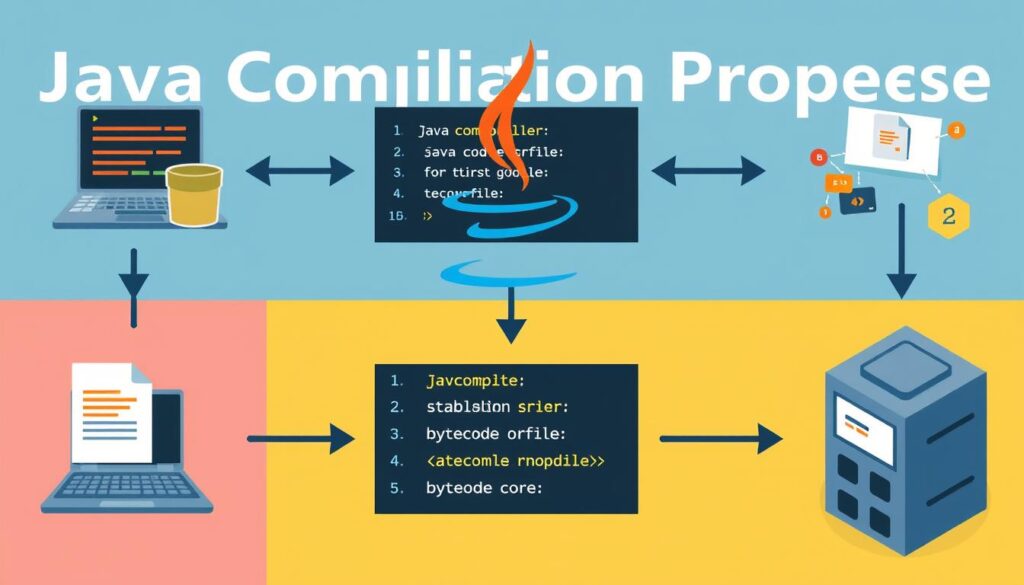Ever wondered how Java programs run smoothly on many devices? It’s all about how Java compiles and runs source code. We’ll look at how Java source code turns into executable bytecode. This process makes Java a top choice for developers everywhere.

What makes Java so special? It’s the “write once, run anywhere” feature. We’ll explore Java compilation, from the Java Development Kit (JDK) to the Java Virtual Machine (JVM). By the end, you’ll know how your Java code becomes ready for many systems, no matter the hardware or operating system.
Key Takeaways
- Java source code is transformed into bytecode, a platform-independent format that can be executed by the Java Virtual Machine (JVM).
- The Java compiler (javac) is a crucial tool in the compilation process, converting human-readable source code into bytecode.
- The JDK (Java Development Kit) provides the necessary tools and libraries for writing, compiling, and running Java programs.
- Bytecode contains instructions that the JVM can interpret and execute, enabling Java’s “write once, run anywhere” capability.
- Understanding the compilation process and the structure of bytecode is essential for Java developers to optimize their code and troubleshoot any issues.
Understanding Java Compilation Basics
Java compilation is a fascinating field for enthusiasts. At its core, the Java language uses java source code. This is the code that developers write. To make this code work, we use tools from the Java Development Kit (JDK), like the javac compiler.
The Java compilation process has two main steps. First, the source code turns into bytecode. Then, the Java Virtual Machine (JVM) runs this bytecode. This makes Java programs work on many different systems.
What is Java Source Code?
Java source code is the base of any Java app. It’s the code that developers write. This code is easy for humans to read and is the first step to making a program that computers can run.
Role of Java Development Kit (JDK)
The Java Development Kit (JDK) is key for Java development. It includes the javac compiler. This compiler turns Java source code into bytecode. The JVM then runs this bytecode, making Java programs work on many platforms.
Introduction to Bytecode
Bytecode is a special form of Java code. It’s made to be run by the JVM. It’s a mix of instructions and data. This makes Java programs work on different systems, thanks to the JVM.
Learning about Java compilation shows us how great the Java language is. It’s a big part of the software world today.
Which Program is Used to Compile Java Source Code into Bytecode
The javac compiler is the hero of the Java world. It turns Java source code into bytecode that runs our digital world. It’s part of the Java Development Kit (JDK) and checks your code’s syntax and semantics.
Unlike the Java Runtime Environment (JRE), javac only focuses on compiling code. It dives deep into your source code, checking and optimizing each line. This makes the bytecode efficient and reliable.
| Feature | Description |
|---|---|
| Syntax and Semantic Checks | javac checks your Java code against strict rules before making bytecode. |
| Bytecode Generation | After checking, javac turns your code into bytecode for the JVM. |
| Class File Creation | The final step is creating .class files with the compiled bytecode. |
Using javac, Java developers know their code will be reliable and efficient. This is key to Java’s success. It’s why Java is so popular and widely used today.
Java Compilation Process Step by Step
As a Java developer, knowing the compilation process is key. It helps you make your code better and use the Java Virtual Machine (JVM) to its fullest. Let’s explore how source code turns into bytecode, a core part of Java.
Source Code Writing and Validation
The journey starts with writing Java source code. Developers use tools like Eclipse, IntelliJ IDEA, or NetBeans. These tools check your code as you write it, making sure it follows Java’s rules.
Abstract Syntax Tree (AST) Generation
After checking the code, the compiler makes an Abstract Syntax Tree (AST). This tree shows how the code is structured. It’s the base for the next part of the compilation process.
Bytecode Generation and Class File Creation
The last step is turning the AST into bytecode. This bytecode is made to work on any system. It’s then put into class files. These files can run on any system with the right Java Virtual Machine (JVM).
The Java compilation process makes code work on any platform. This means you can write code once and use it everywhere. Knowing this process helps you make your Java apps better and more efficient.

Inside the Java Virtual Machine (JVM)
The Java Virtual Machine (JVM) is at the heart of the Java platform. It’s responsible for running Java bytecode. It has key parts like the class loader, bytecode verifier, and execution engine. These work together to understand and run the compiled code.
The JVM’s main job is to run bytecode. This is the code the Java compiler makes. It’s special because it can run on any system with a JVM, no matter the hardware.
The Just-In-Time (JIT) compiler is a big help for the JVM. It looks at the bytecode and turns the most used parts into native code. This makes Java apps run faster. It makes sure Java code works well on many systems.
The JVM’s design is key to Java’s famous Write Once, Run Anywhere (WORA) feature. It hides the details of the hardware and operating system. This lets Java developers write code that works on any Java platform, without needing to change it for each system.
| JVM Component | Description |
|---|---|
| Class Loader Subsystem | Responsible for loading, linking, and initializing Java classes and interfaces. |
| Bytecode Verifier | Ensures the safety and security of the bytecode by validating its integrity and compliance with the Java language specification. |
| Execution Engine | Interprets and executes the bytecode, leveraging the JIT compiler to optimize performance. |
Learning about the java virtual machine helps developers understand how Java apps work. It leads to better and faster software.

Bytecode Structure and Components
As a Java developer, knowing about bytecode structure is key. It helps us understand how the Java Virtual Machine (JVM) runs our code well. Let’s look at the main parts of bytecode, starting with the class file format.
Class File Format
The Java bytecode is stored in a class file. This file follows a specific format set by the Java Virtual Machine Specification. It includes the compiled bytecode instructions and other data like the constant pool and method area. Knowing the class file format helps us see how the JVM runs the bytecode.
Bytecode Instructions
Bytecode instructions are the core of Java apps. They cover actions like loading variables, doing math, calling methods, and controlling flow. Each instruction has a unique code that the JVM knows and carries out.
Constant Pool and Method Area
The constant pool in the class file holds constants like strings and references. These constants help the bytecode instructions work with data during execution. The method area, on the other hand, keeps the compiled methods and their details.
Exploring Java bytecode’s structure and parts shows us how the JVM runs our code efficiently. It’s platform-independent. Knowing this helps us make our Java apps better, faster, and work well everywhere.
FAQ
What is Java source code?
Java source code is the programming statements written by developers. It’s the original code in the Java language.
What is the role of the Java Development Kit (JDK)?
The Java Development Kit (JDK) has tools for Java development. The javac compiler is used to turn Java source code into bytecode.
What is bytecode in the context of Java?
Bytecode is a middle step in Java code execution. It’s what the Java Virtual Machine (JVM) runs. It connects the source code to the JVM’s instructions.
Which program is used to compile Java source code into bytecode?
The javac compiler, part of the JDK, is key for this. It checks the source code and then makes bytecode.
Can you explain the Java compilation process step by step?
The Java compilation process has several steps. First, source code is written and checked. Then, an Abstract Syntax Tree (AST) is made. Finally, bytecode is created and turned into class files.
How does the Java Virtual Machine (JVM) execute bytecode?
The JVM runs Java bytecode. It has parts like the class loader and execution engine. Its design and Just-In-Time (JIT) compilation make Java work on any platform.
What is the structure of Java bytecode?
Java bytecode has a clear structure for the JVM to run it. It includes the class file format and the constant pool. These parts help the JVM execute the code efficiently.
Also Read
How to Create a College Website Using HTML and CSS Code Free
